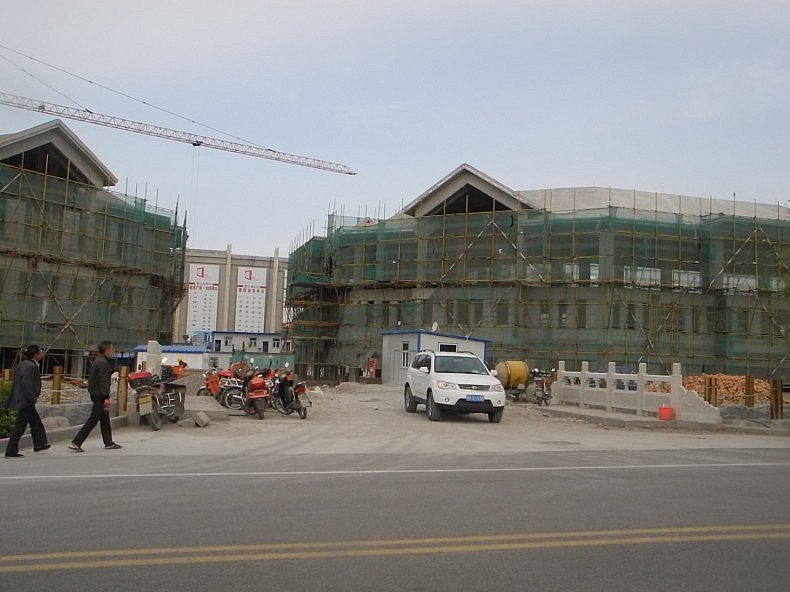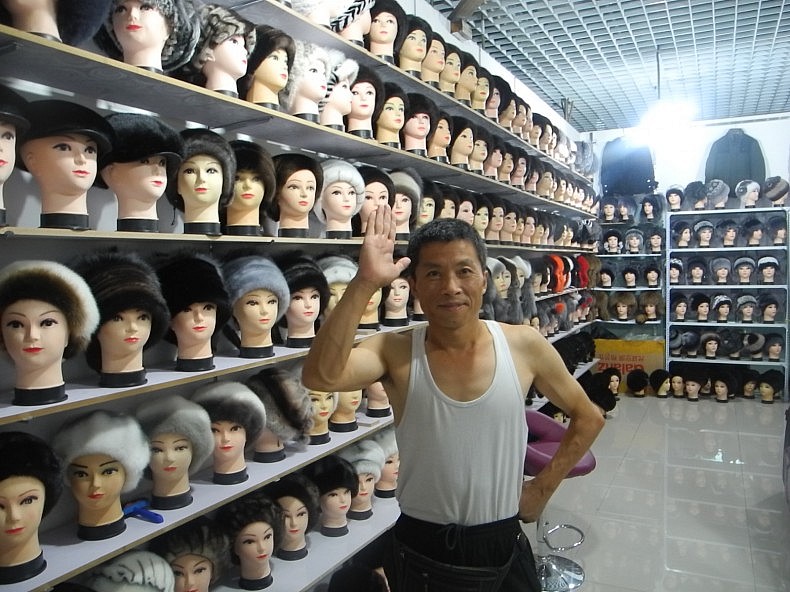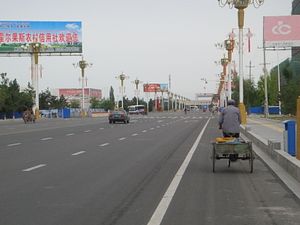Hardly a year ago the city of Horgos didn’t exist. It was little other than a rural expanse of small towns, villages, and lavender fields on the farthest fringe of China’s Xinjiang Autonomous Region, right on the border with Kazakhstan. Once a vibrant junction on the ancient Silk Road, Horgos endured a long descent into obscurity as the trade routes that were its lifeblood dried up, leaving it marooned from the rest of the world by sheer distance, mountains, and deserts. Now, it is precisely this frontier position that has brought Horgos and many of Xinjiang’s other cities to the forefront of China’s national policy, and the influx of development and urbanization which has followed has severely affected the region’s local people and traditional cultures.
Horgos was formally named a municipality on June 29, 2014. With this elevation of status came $3.25 billion in investment from the central government and a hundredfold increase in land area. The reason for this newfound relevance was clear: Horgos was to become the main land port of China’s Belt and Road initiative, a $140 billion network of trade corridors, ports, pipelines, and logistics zones stretching from East Asia to Europe that is otherwise known as the New Silk Road.
As the benefits of shipping overland between Asia and Europe become more evident, trade relations with the countries of Central Asia continue to grow, and industry continues moving inland, the importance of China’s western frontiers has increased proportionally. The vision is to develop some of the cities in Xinjiang, China’s westernmost region, into an economic counterweight to balance out the booming cities of the country’s east coast. If Shanghai, Guangzhou, and Shenzhen became hubs of global commerce due to the international access their sea ports provided, then why shouldn’t the land ports on the western borderlands experience a similar prosperity? With $16.3 billion in investment from the central government, Xinjiang cities like Horgos, Kashgar, and Alataw are being built up to be major economic and logistics hubs — ports for trains and trucks instead of ships.
These recent New Silk Road projects are part of a much broader initiative to develop Xinjiang. In 2012, the government of Xinjiang announced a 20-year plan to completely revamp and urbanize the region with expanded cities, new cities, a fresh grid of transport infrastructure. The goal was to raise the urbanization rate to 68 percent. Once-obscure places like Yining, Karamay, and Aksu are being turned into booming centers of culture and commerce and Beijing is currently constructing 20 special industrial zones in the region to bolster manufacturing, cross-border trade, and create more jobs. A high-speed rail line connecting Urumqi to Lanzhou is already in operation and the Lianhuo Expressway bisects Xinjiang neatly through the middle, tying some of its major cities and the border with Kazakhstan to the east coast.

New buildings under construction on the road to the Horgos International Center of Boundary Cooperation, a free trade zone that is shared with Kazakhstan, China’s only international FTZ. Photo by Wade Shepard.
Systematic, urbanization-by-fiat is also nothing new here. The Xinjiang Production and Construction Corps (XPCC), locally known as the Bingtuan, was created by Mao Zedong in 1954 and assigned the task of making use of the vast land area of Xinjiang while remaining armed and on guard against a potential Soviet invasion. With an initial group of 175,000, made up mostly of exiled Nationalist soldiers and impressionable youth bent on doing their share of nation building, the Bingtuan began turning desert into farmland and taming China’s restive western hinterlands. The XPCC was set up as a do-it-all kind of organization, and eventually began functioning as a large company, a military, and a governing body rolled up into one. They took control of an area the size of Ireland, established large scale farming operations, built and ran schools, universities, hospitals, and prisons all while constructing entirely new cities.
Now with 2.7 million members, comprising nearly 12 percent of Xinjiang’s total population, the XPCC has remained a dominant force in regional affairs. In 1998 they were formally given administrative status on par with Xinjiang’s regional government. The organization itself is currently a multi-billion dollar business which contributes a full 17 percent of Xinjiang’s GDP, manufactures 40 percent of the region’s wool, and exports 17 percent of the world’s ketchup. To date, the XPCC has built seven completely new cities and has plans for constructing dozens more.
The actions of the XPCC have been contested since its inception, often because there were already people living in the areas they took over in the name of development and security.
“They occupied all the fruitful land in East Turkestan, all the rivers, all the water sources,” claimed Omer Kanat, the general secretary of the Uyghur-American Association, a Washington, DC-based Uyghur advocacy group.
One of the common complaints against the XPCC is that they forcibly appropriated land from local farmers, took complete control of the area’s natural resources, and shipped in millions of Han migrants, leaving many of the local people marginalized within their own region.
Following closely on the heels of urbanization and economic development in Xinjiang is the mass migration of Han Chinese looking to benefit from new opportunities on the frontier. At the time the Communist Party came to power, the Han population of Xinjiang was just 6.7 percent of the region’s total, while 75 percent were Uyghurs, a Turkic and mostly Muslim ethnic group. In the intervening years, Han settlers began flooding into the region and now constitute 40 percent of the region’s total population, while the percentage of Uyghurs dropped to a mere 45 percent.
The new city of Horgos displays this demographic shift clearly. The streets there are full of migrant workers lured in from cities across the country on the promise of paychecks. They gather in the new central park; the women engaging in their nightly line dancing routine while the men stand around in a circle smoking cigarettes and watching them. At the end of Ya’ou Boulevard is the border post; when you first cross through it into town you are met by a mob of Han taxi drivers, money changers, and trinket peddlers who welcome you to their country with prying invitations to purchase their services and wares. Adjacent to the border post are the gates of the nascent free trade zone, a place where mostly Han small-time traders buy and sell cheap Chinese manufactured goods.
This influx of migrants and workers from other parts of China creates competition for the local Uyghurs and other minority ethnicities for employment, farming rights, and resources. Most of the region’s top jobs, especially in the petrochemical industry, are disproportionately taken up by Han workers, many of which are intentionally shipped in from other parts of the country. Through an analysis of 2005 census data it was found that Uyghur workers in Xinjiang, on average, earn just 66 percent of what their Han counterparts do.

A Chinese merchant who sells fur wigs and hats in the Horgos free trade zone. Photo by Wade Shepard.
“The arrival of migrants to Xinjiang taking advantage of economic opportunities is perceived by the government as an effective device within the development framework for the goal of political consolidation,” said Henryk Szadziewski of the Uyghur Human Rights Project. “However, inequitable distribution of economic benefits and a social and cultural transformation in the region has magnified ethnic tensions.”
Those ethnic tensions have occasionally manifested themselves in acts of violence ranging from bombings and attacks on police stations to riots.
It is often posited by the Chinese government and media that the ethnic problems in Xinjiang primarily stem from issues related to poverty. As development and urbanization have been one of the main drivers behind the social ascension of hundreds of millions of people across the country it was logically concluded that more development was precisely what was needed to stem discontent in Xinjiang. So most urbanization projects in the regions are backed by the reasoning that they’re being done to help the Uyghurs and other minorities modernize and improve their living standards and socio-economic wellbeing.
“The Chinese government have drawn links between poverty and extremism in Xinjiang,” said Nick Holdstock, the author of China’s Forgotten People, “though often without acknowledging that government policy and ethnic discrimination are at least partly responsible for the greater poverty and unemployment found in many Uyghur communities. Development might well be a way to reduce discontent in Xinjiang, but this can only work if the benefits are equally shared.”
Inherent to the physical process of urbanization is the demolition of traditional Uyghur neighborhoods and the mandatory eviction and relocation of the people living there. The old city of Kashgar is a prime example of how this process plays out in practice.
“The old city of Kashgar was demolished by the Chinese authorities and the Uyghurs were forced to move to the outskirts to apartment blocks,” Kanat explained. “In these apartment buildings they feel very alone; they don’t know their neighbors. What’s happening now is that these people are complaining that they are losing their old relationships and also their traditions and culture.”
“The destruction of old neighborhoods has caused communities to fragment, with many households being forced to move to the urban periphery,” Holdstock explained. “As in other places in China, the loss of people’s homes and the break up of neighborhoods has damaged the social fabric, and threatens many aspects of intangible culture.”
Forced evictions and demolitions are a source of discontent all over China. Sixty-four million families across the country have had their homes forcibly requisitioned by the government to make way for development since the beginning of the economic boom period. According to official figures, 80 percent of the 20,000 formal grievances filed with the government each day and 65 percent of the 180,000 mass social disruptions which occur across the country each year are due to issues related to the seizure of property. Put succinctly, the Chinese salve for soothing ethnic tensions in Xinjiang may in fact be one of its prime irritants.
This is especially true when we consider that along with new apartments in new cities, Xinjiang’s Uyghurs and other ethnic minorities are also being given a new language and a new worldview pumped in via the education system. As urbanization, globalization, and Han integration grows, the need for ethnic minorities in XInjiang to speak Mandarin increases, as those who don’t are at a severe economic and social disadvantage. Mandarin is now the main language of instruction in Xinjiang schools, and some Uyghurs fear that their native language is becoming obsolete.
“We don’t say that Uyghurs shouldn’t speak Chinese or Uyghurs shouldn’t study Chinese,” Kanat stated. “They should be able to speak the Chinese language in order to compete with the Han Chinese in the society. But at the same time they are a different ethnic group so they should be able to adapt to Chinese society by keeping their own culture, their own traditions, their own ethnic identity.”
Construction projects ripple out from the center of Horgos, extending farther and farther out into the farmland beyond. Yet another remote, rural nowhere is being turned into a city within a five year plan or two. With this rapid transition comes a promise of more jobs, better schools, better infrastructure, better social benefits, better access to the world beyond, and a higher standard of living. Xinjiang’s Uyghurs and other ethnic minorities are not completely removed from the benefits of this development. Calculable living standards are rising for all ethnicities across the board in Xinjiang, and those who go through the Chinese educational system and embrace urbanism, globalism, and some would say “Han-ification” often have a world of opportunities that were not available even a generation before.
“To China’s credit, they do try to co-opt Uyghurs in their development plans,” said Julia McClenon, an American researcher who has written about the ethnic situation in Xinjiang. “It’s one of the reasons why many of their policies have been effective in that regard. So there is some participation, but I think among culturally educated Uyghurs there is also an understanding that those Uyghurs who do participate in these development plans are definitely influenced by Beijing.”
The social impact of urbanization in Xinjiang is often double-edged. “The loss of tangible Uyghur cultural heritage through demolitions such as the one in Kashgar is sometimes set against the benefits and conveniences of Old City Uyghurs relocating to modern apartments. While the loss in status of the Uyghur language is contrasted with the economic advantages and social advancement made possible through a Mandarin language education,” Szadziewski explained.
Urbanization and the technological connectivity that it provides has also created new ways for Xinjiang’s minority ethnicities to maintain an awareness of themselves and seek information and influence beyond what is handed to them by their government and education system.
“The pace of transformation in Xinjiang is breakneck and traditional markers of the Uyghur identity are under pressure from government policies; however, younger Uyghurs are displaying a resilience to this pressure through a redefinition and restatement of what it means to be Uyghur,” explained Szadziewski. “The globalizing of the Uyghur youth demonstrates that young Uyghurs are as open to the outside world as their contemporaries and this fluency in other cultures offers alternatives to the model proposed by the Chinese government. Furthermore, while urbanized Uyghurs share in a globalized culture, many are returning to their language and religion as a means of reestablishing their Uyghur identities.”
Wade Shepard is a journalist and author of Ghost Cities of China.
































